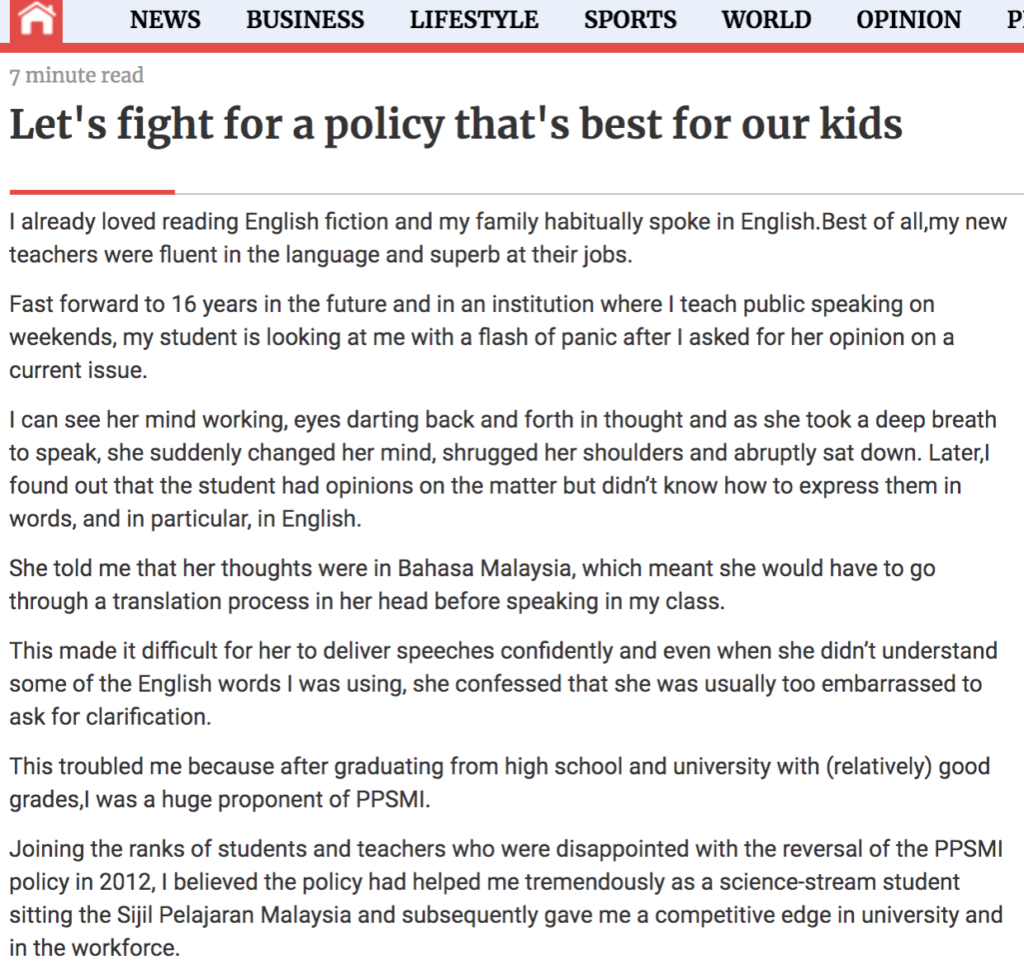I was only 13 years old when the government decided to introduce the Pengajaran dan Pembelajaran Sains dan Matematik Dalam Bahasa Inggeris (PPSMI) policy into primary and secondary schools in Malaysia. At that time, I had completed my Ujian Pencapaian Sekolah Rendah (UPSR) and was enrolled in a new private secondary school. Unaware of the heated debate behind the policy, I was thrilled about the change. I already loved reading English fiction books and my family habitually spoke in English. Best of all, my new teachers were fluent in the language and superb at their jobs.
Fast forward to 16 years in the future and in an institution where I teach public speaking on weekends, my student is looking at me with a flash of panic after I had asked for her opinion on a current issue. I can see her mind working, eyes darting back and forth in thought and as she took a deep breath to speak, she suddenly changed her mind, shrugged her shoulders and abruptly sat down.
Later, I found out that the student had opinions on the matter but didn’t know how to express them in words, and in particular, in the English language. She told me that her thoughts were in Bahasa Malaysia, which meant she would have to go through a translation process in her head before speaking in my class. This made it very difficult for her to deliver speeches confidently and even when she didn’t understand some of the English words I was using, she confessed that she was usually too embarrassed to ask for clarification.
PPSMI’s Past
This troubled me because after graduating high school and university with (relatively) good grades, I was a huge proponent of PPSMI. Joining the ranks of students and teachers who were disappointed with the reversal of the PPSMI policy in 2012, I believed the PPSMI policy had tremendously helped me as a science-stream student sitting for Sijil Pelajaran Malaysia (SPM) and subsequently, gave me a competitive edge in university and in the workforce. Now that the debate on the PPSMI policy is once again on the table, I am not so certain. In hindsight, I realized that my circumstances put me in a very advantageous situation in relation to studying Science and Maths in the English language. I was fortunate to be fairly fluent in English and was enrolled in a private institution where the teachers were highly trained and effortlessly bilingual. Others were not so fortunate. I suddenly recalled conversations with my cousins during Eid celebrations back in the kampung where they told me of their struggles with the switch in the medium of instruction and the difficulty they had in understanding new concepts.
Personal experiences and observations aside, let’s look at some hard truths. While it is undeniable that the English language is universal, with over 400 million native English speakers worldwide and more than 700 million people using English as a foreign language, context is nevertheless very important.
In a context where the government had flip-flopped on this issue to the detriment of all stakeholders in the past, getting it done right is more important than getting it done quick. With the bill to amend the constitution to lower the voting age from 21 to 18 being recently passed, education is of utmost importance in order to better prepare our youths for the future. Therefore, even though the PPSMI policy has in the past been riddled with issues of politics, race, culture and nationality, it is now time to put such sentiments aside, capitalize on the spirit of bipartisan support, and truly fight for a policy that is best for our future; our children.
The English Effect
So is the English language important to advance a country and its people’s economic situation? The short answer is yes. According to the 2018 EF English Proficiency Index, which analysed the results of 1.3 million test-takers in 400 regions and countries, it was found that English proficiency correlates with a higher gross domestic product (GDP), higher average gross income, better ease of doing business and increase in general productivity. Asian countries with strong English proficiency are seen to be thriving. Singapore has consistently been placed in the top 10 spot of the report and since 1960, has had a trade to GDP ratio of over 300%. Unfortunately, as of 2018, Malaysia had dropped to 22nd place in English proficiency from 13th place in 2017. This is worrying.
Though many naysayers would quickly point to Japan and China as good examples of maintaining the mother tongue, this study also found Japan and China riding the waves of change. In China, 70% of parents were reported to want more English to be taught in school fuelling the local English learning industry which is estimated to grow at a rate of 22% annually. Since 2017, there are more than 1million foreign workers in Japan and on a corporate level, companies like Rakuten, Honda and Nissan have long used English as their corporate language. By 2020, English will become an official subject in primary schools (currently only taught in High Schools).
Teaching in English
This then begs another important question – is using a foreign language as a medium of instruction good for student comprehension? The short answer to this is no. A quick Google search and several articles later, I found many examples around the world where students were disadvantaged by being taught in an unfamiliar language.
A study done in Cameroon observed 12 schools which taught children in Kom, their local language, rather than English, within the first 3 years of school. It was found that the Kom-medium students achieved better grades than the English-medium students in their third-year and in their fifth year, did even better in the English language than the English-medium students.
Another study done on children in various regions in Ethiopia found that where the native language was used as a medium of instruction until upper primary school, children there performed better than the children who were taught only in English from the beginning.
A 2013 study done in Andhra Pradesh, India on the performance of private schools vis-a-vis government schools discovered that private school students performed better than government school students but students in Telugu-speaking private schools performed much better in maths than those in English-medium schools.
The Malaysian Context
So how then do we bridge the gap between needing to increase Malaysia’s English proficiency levels to fuel economic growth yet ensure that students understand the concepts being taught in a foreign language? Unfortunately, there is no short answer to this. Echoing the sentiment of Malaysia’s National Union of Teaching Profession urging the government to learn from its past mistakes, a “bottom-up approach” is needed to sustain the PPSMI policy. I believe more should be done to improve teacher education in Malaysia. Maths and Science teachers should be bilingual, to better understand and teach the subjects being taught. All schools, more so in those situated in rural areas, would need to retrain their teachers to adapt to the change. Across the board, standards of English proficiency should also be improved by investing more in English education and IT capabilities. It is important to ensure that students not only understand English as a subject but consequently, comprehend English as a medium of instruction. Failure to do both would lead to students not learning English, and not learning anything at all.
In the public sector, more should be done to supplement the government’s existing Dual Language Programme (DLP) which gives certain schools the option to teach Science and Maths in English. As at 2018, there are 22,960 primary and secondary students enrolled in DLP with Phase 1 of the program resulting in 36.28% of primary school pupils and 46.44% of secondary school students achieving better results for their English language exams from 2016 to 2017. According to the Deputy Education Minister, Teo Nie Ching, “The result of the comparison (for Phase 2 of the study which compared English language result for mid-2017 and final exam results at end 2017) found that around 55.82% of primary school pupils and 57.23% of secondary school students showed an increase in the English language.”
Many Malaysian parents are keen on improving their child’s marketability in the workforce and like the Parent Action Group for Education (PAGE), applaud the possibility of reintroducing PPSMI into the education system. In fact, when the PPSMI policy was reversed in 2012, parents flocked to the private sector, enrolling their children into private international schools to take the International General Certificate of Secondary Education (IGCSE) instead of SPM. Statistics released by the Malaysian Cambridge Assessment International Education found that as of 2017, the number of local students sitting for IGCSE rose by 293% to 8,800 from only 3,000 in 2012.
Putting racial, nationalistic and political sentiments aside, I believe that everyone is eager. Parents are eager to better equip their children for the future. The government is eager to reintroduce a sustainable version of the PPSMI policy. I am eager for my students to speak confidently in English, empowered by better proficiency and understanding. Nevertheless, we must ensure that Malaysia is not only eager and willing, but also able and ready for the change.


The Star and NST Article Links:

